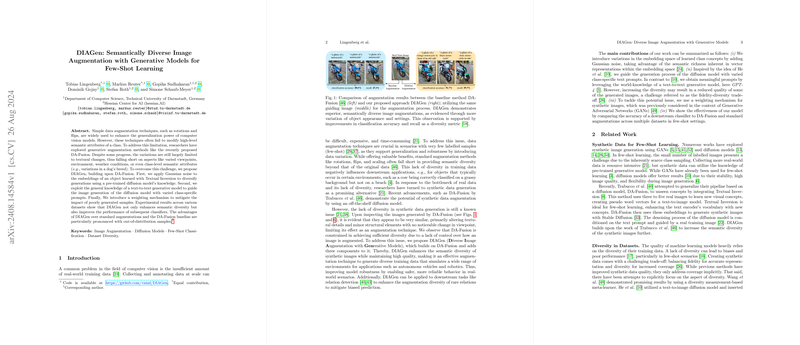DIAGen: Semantically Diverse Image Augmentation with Generative Models for Few-Shot Learning
The paper "DIAGen: Semantically Diverse Image Augmentation with Generative Models for Few-Shot Learning" by Lingenberg et al. addresses an inherent limitation in standard data augmentation techniques used in computer vision, commonly observed in few-shot learning scenarios. Traditional augmentation methods such as rotations, flips, and scaling, while effective at enhancing data diversity, lack the ability to introduce high-level semantic variations in the data. The proposed method, DIAGen, seeks to overcome this challenge by leveraging generative models to enhance the semantic diversity of synthetic images, thereby improving the performance of downstream classifiers when only a few labeled examples per class are available.
Methodology
DIAGen builds upon DA-Fusion by integrating three novel components:
- Embedding Noise Addition: DIAGen introduces Gaussian noise into the embedding space of class representations learned through Textual Inversion, thus leveraging the pre-trained diffusion model's knowledge to produce semantically diverse image generations. This adaptation operates on the hypothesis that minor perturbations in the learned class concept vectors will translate into varied yet semantically consistent image outputs.
- LLM-Guided Prompting: To further control and enhance the diversity of the generated images, DIAGen employs a text-to-text generative model, specifically GPT-4, to generate varied class-specific prompts. This approach utilizes the extensive world knowledge encoded in GPT-4 to produce meaningful and contextually rich prompts, thereby guiding the diffusion model to generate images that are not only semantically varied but also broader in scope concerning environments, viewpoints, and other high-level attributes.
- Weighting Mechanism: To mitigate the potential quality degradation of synthetically generated images, DIAGen introduces a weighting mechanism that assigns confidence scores to generated images using a classifier trained on the original data. Images with lower scores are assigned lower weights during the training phase, thus ensuring that only high-fidelity synthetic images significantly influence the downstream model training.
Experimental Results
Empirical evaluations demonstrate that DIAGen outperforms both DA-Fusion and standard augmentation techniques across multiple datasets, including FOCUS, MS COCO, Custom COCO, and an additional test set designed to evaluate the model's performance on out-of-distribution (OOD) samples, termed Uncommon Settings. The results show consistent performance improvements, with classification accuracy gains of up to 5% compared to DA-Fusion and even higher gains relative to standard augmentations.
Implications and Future Developments
The primary contribution of DIAGen lies in its ability to enhance the semantic diversity of synthetic images, which translates into improved generalization for downstream classifiers, particularly in few-shot learning scenarios. By enabling the generation of images that capture a wider variety of environments and contexts, DIAGen is instrumental in reducing dataset biases and increasing the robustness of computer vision models.
The implications of this research extend beyond academic interest, offering practical benefits for applications where data collection is resource-intensive or where models must generalize well to rare or unseen scenarios. For instance, in autonomous driving where the ability to recognize and appropriately respond to rare or unusual road conditions is critical, DIAGen can contribute to synthesizing diverse training datasets that enhance model training.
Conclusion
DIAGen represents a significant advancement in image augmentation for few-shot learning by combining embedding noise, LLM-guided prompt generation, and a confidence-based weighting mechanism. While the paper confirms substantial improvements in both precision and recall of synthetic datasets, future research might explore finer adaptations, such as further tuning the interplay between noise and LLM prompts or extending DIAGen's application to other domains beyond image classification. Nonetheless, DIAGen stands as a robust framework for enhancing semantic diversity and improving the resilience and generalization capabilities of computer vision models in scarce data scenarios.
By dwelling on such nuanced details and empirical results, the paper effectively broadens the horizons for future explorations in the field of generative data augmentation.
